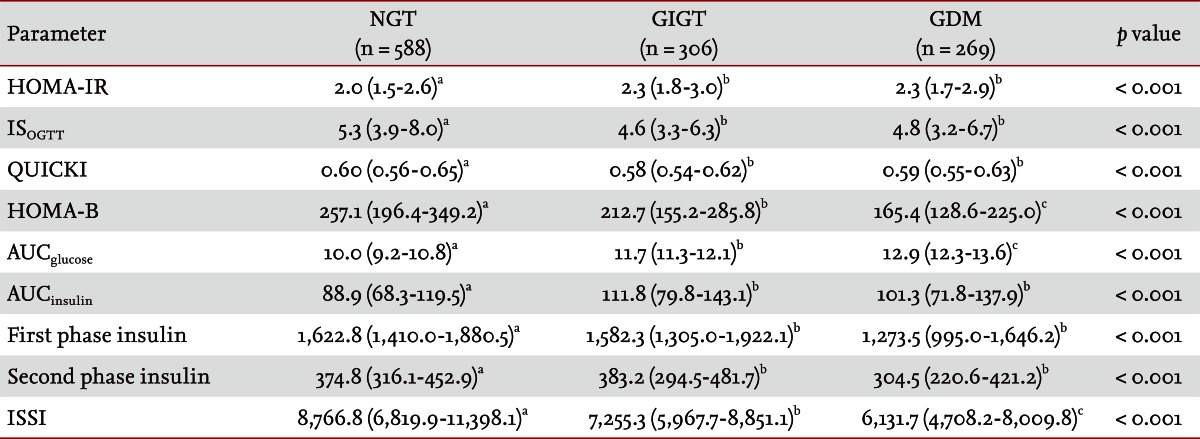1. Metzger BE. Summary and recommendations of the Third International Workshop-Conference on Gestational Diabetes Mellitus. Diabetes 1991;40(Suppl 2):197–201PMID : 1748259.

2. Jang HC. Diagnostic criteria for gestational diabetes in Korean women: is new ADA criteria appropriate? J Korean Diabetes Assoc 2002;26:221–228.
3. Hong EK, Cho YW, Chang HC, Park HK, Cho N. Assocation of type 2 diabetes development and obesity in history of gestational diabetes 2001. In : 14th Spring Congress of Korea Diabetes Association; 2001 May 18-19; Seoul: Korea Diabetes Association, p. 180.
4. Jacobson JD, Cousins L. A population-based study of maternal and perinatal outcome in patients with gestational diabetes. Am J Obstet Gynecol 1989;161:981–986PMID : 2801849.


5. Kim C, Newton KM, Knopp RH. Gestational diabetes and the incidence of type 2 diabetes: a systematic review. Diabetes Care 2002;25:1862–1868PMID : 12351492.


6. Fisher PM, Sutherland HW, Bewsher PD, Campbell A. The pathophysiology of chemical gestational diabetes. Br J Obstet Gynaecol 1977;84:234.

7. Endo S, Maeda K, Suto M, et al. Differences in insulin sensitivity in pregnant women with overweight and gestational diabetes mellitus. Gynecol Endocrinol 2006;22:343–349PMID : 16785160.


9. Carpenter MW, Coustan DR. Criteria for screening tests for gestational diabetes. Am J Obstet Gynecol 1982;144:768–773PMID : 7148898.


10. Bonora E, Targher G, Alberiche M, et al. Homeostasis model assessment closely mirrors the glucose clamp technique in the assessment of insulin sensitivity: studies in subjects with various degrees of glucose tolerance and insulin sensitivity. Diabetes Care 2000;23:57–63PMID : 10857969.


11. Matthews DR, Hosker JP, Rudenski AS, Naylor BA, Treacher DF, Turner RC. Homeostasis model assessment: insulin resistance and beta-cell function from fasting plasma glucose and insulin concentrations in man. Diabetologia 1985;28:412–419PMID : 3899825.


12. Matsuda M, DeFronzo RA. Insulin sensitivity indices obtained from oral glucose tolerance testing: comparison with the euglycemic insulin clamp. Diabetes Care 1999;22:1462–1470PMID : 10480510.


13. Katz A, Nambi SS, Mather K, et al. Quantitative insulin sensitivity check index: a simple, accurate method for assessing insulin sensitivity in humans. J Clin Endocrinol Metab 2000;85:2402–2410PMID : 10902785.


14. Stumvoll M, Van Haeften T, Fritsche A, Gerich J. Oral glucose tolerance test indexes for insulin sensitivity and secretion based on various availabilities of sampling times. Diabetes Care 2001;24:796–797PMID : 11315860.


15. Piche ME, Lemieux S, Corneau L, Nadeau A, Bergeron J, Weisnagel SJ. Measuring insulin sensitivity in postmenopausal women covering a range of glucose tolerance: comparison of indices derived from the oral glucose tolerance test with the euglycemic-hyperinsulinemic clamp. Metabolism 2007;56:1159–1166PMID : 17697856.


16. Yi KW, Jung JW, Shin JH, et al. Perinatal outcomes in pregnant women with impaired glucose tolerance (IGT) proven through 100 g oral glucose tolerance test (OGTT). Korean J Perinatol 2006;17:25–32.
17. Lee WJ, Ahn SH, Kim HS, et al. Clinical manifestations and perinatal outcomes of pregnancies complicated with gestational impaired glucose tolerance and gestational diabetes mellitus. Korean J Obstet Gynecol 2001;44:1033–1039.
18. Buchanan TA, Metzger BE, Freinkel N, Bergman RN. Insulin sensitivity and B-cell responsiveness to glucose during late pregnancy in lean and moderately obese women with normal glucose tolerance or mild gestational diabetes. Am J Obstet Gynecol 1990;162:1008–1014PMID : 2183610.


19. Ryan EA, Imes S, Liu D, et al. Defects in insulin secretion and action in women with a history of gestational diabetes. Diabetes 1995;44:506–512PMID : 7729607.


21. Yoon KH, Lee JH, Kim JW, et al. Epidemic obesity and type 2 diabetes in Asia. Lancet 2006;368:1681–1688PMID : 17098087.


23. Lopez-Ridaura R, Willett WC, Rimm EB, et al. Magnesium intake and risk of type 2 diabetes in men and women. Diabetes Care 2004;27:134–140PMID : 14693979.


24. Lambert JM, Moshfegh A, Hainaut P, Wiman KG, Bykov VJ. Mutant p53 reactivation by PRIMA-1MET induces multiple signaling pathways converging on apoptosis. Oncogene 2010;29:1329–1338PMID : 19946333.


25. Nielsen TF, Rylander R. Urinary calcium and magnesium excretion relates to increase in blood pressure during pregnancy. Arch Gynecol Obstet 2011;283:443–447PMID : 20135136.












 PDF Links
PDF Links PubReader
PubReader ePub Link
ePub Link Full text via DOI
Full text via DOI Download Citation
Download Citation Print
Print


